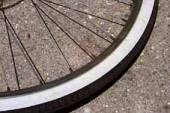Bicycle Spokes
M. Lindamood
From competitive racing to simply the bicycle you use to get to class- materials design applications are all around you. Take a look at the simple two-wheeled mechanism called a bicycle. To a materials engineer this is "design heaven". The wheels, seat, handlebars, and frame are all comprised of different materials that when adjusted just right can make one bicycle more desirable than another. For simplification matters and to prove that even looking at just one part of the bicycle is a complicated process I shall talk about the material design applications behind the bicycle spokes.
Spokes are the connecting rods between the bicycle hub and the rim. Their main purpose is to transfer the loads between the hub and the rim, which are caused by the weight of the rider and the bike. Ever wondered if the bike spokes are laced to the rims in a pattern? The lacing of the spoke is most commonly tangentially attached. This means the spoke on the ground has almost no load because the load is distributed among the other spokes.
The materials engineer asks now, "What material to make the spokes?" The obvious answer is steel, but should it be a stainless steel or high-carbon steel. The choice here depends on corrosion resistance or fatigue failure- whichever one the rider deems more important. The stainless steel would resist corrosion due to the amounts of chromium whereas the carbon containing steel must have a protective layer applied over the steel to prevent rust.
The materials engineer is now faced with the question of how much chromium in the steel spoke is needed for optimum results. This varies from company to company but a rule in materials science is that to be a stainless steel it must have at least 12% chromium. Making of the spokes is another area that the materials engineer would put into practice their knowledge. Drawing the rods through dies until the wire is of the desired diameter makes the spokes. This drawing process creates dislocations (a crystalline defect) in the wire which increases the strength. But the process has to be timed perfectly. Too much drawing and the spoke could break; not enough, and the wire won't carry the load to meet design specifications for the bike.
As one can see even something as simple and everyday as a bicycle spoke is surrounded by materials processes and design concepts leading to an exciting and unrestricted career in Materials Engineering.

